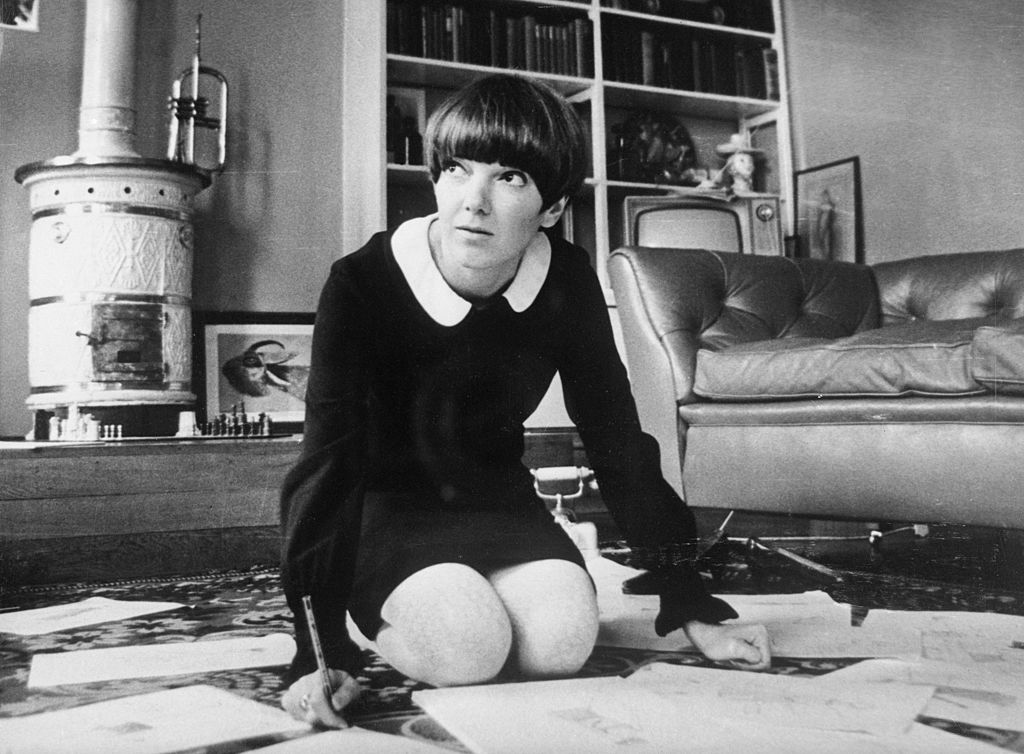The fashion designer and icon Mary Quant has died at the age of 93. Brigid Keenan wrote the following piece in 2019.
It is almost impossible to explain to today’s readers why Mary Quant (and the other Young Designers, as they became known) had such a huge impact. Over the half-century since, there have been so many ‘new’ ideas in fashion that her and their initial shock value has been diluted. Luckily, though, the Christian Dior exhibition is also showing at the V&A, and a quick visit there — look particularly at the fashions of the 1950s — will give you a clue.
Pre-Quant, clothes were constricted: fussy, fitted, buttoned, cuffed, boned. They demanded a lot of the wearer. Mary’s were unstructured and she took her inspiration from surprising places.
Her grey flannel suit that I fell in love with — which my friend who worked in the Quant sewing room replicated for half the price — had a casual jacket, cut like a man’s blazer and a box-pleated skirt. Box pleats were more often used for school skirts in those days (Mary liked adapting school uniform; the pinafore was another favourite). As well as using jersey fabric, which was unusual, she made a feature of zip fasteners rather than hiding them away. She also put men’s braces on skirts and trousers, and she made vests fashionable. And she used PVC for raincoats (shock horror: plastic in fashion!). She didn’t altogether invent the short skirt; the couturier Courrèges did that (I saw it with my own eyes). But she took it to mini heights. She invented hotpants and she launched tights (these had been invented in the US, but Mary produced them in black, yellow, red, shocking pink, green, etc.)
Mary also created the kind of make-up girls were desperate for. We all wanted Beatnik black eyes and, even more, almost-white lipstick, but before Mary you had to find someone going to Paris to buy it for you. She had her own hair cut into a bob by Vidal Sassoon, and inspired a generation to copy her.
Mary and I were not bosom friends (she is painfully shy), but I was often at their office in Ives Street, Chelsea, chatting with her husband Alexander Plunket Greene, or watching their exciting fashion shows (totally different from any others at the time, with loud music, energetic models, contemporary make-up) or choosing clothes to feature.
Time passed and I left the paper. After trying (and failing) to be a famous war reporter in Vietnam, I went back to my true home on the Sunday Times, as fashion editor once again. Mary Quant was about to turn 40. The Queen of Youth, the epicentre of the youthquake, was entering middle age. I phoned Mary to arrange an interview, but she wouldn’t agree. I wrote to her. I sent a bouquet of flowers. But she was adamant: she would not talk about being 40. I thought of something else to write about, but I was hurt and at the back of my mind I held it against her. (Which didn’t stop me from putting her forward for a damehood a few years ago — supported by David Bailey and Terence Conran. It was a serious oversight that she hadn’t received one decades before.)
It’s never too late for life to surprise you. In the course of making the video at the V&A for its Quant exhibition, I discovered why Mary had been so obstinate in her refusal all those years ago. She hadn’t been 40 at all, but 45; she’d lied about her age because she was older than her husband and in those days we kept these things secret. Mary, I am sorry – all is forgiven.







Comments